#alphabetic language
Text
The Importance of Teaching Children to Read Through Letters and Sounds
Reading is a fundamental skill that serves as a cornerstone for a child's education and future success. It opens doors to a world of knowledge, imagination, and critical thinking. One of the most effective methods for teaching children to read is through the use of letters and sounds, also known as phonics. In this article, we'll explore the significance of teaching children to read using letters and sounds, highlighting the numerous benefits it offers in their early development.
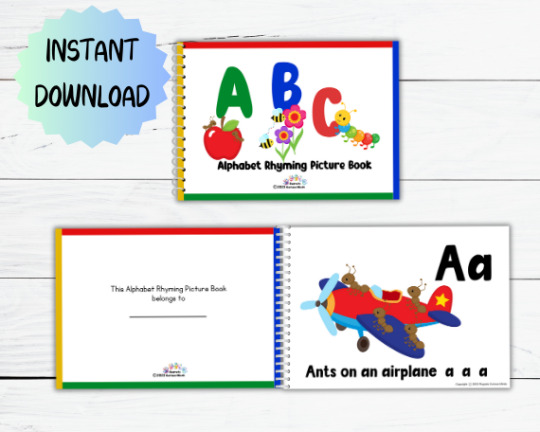
Building Strong Foundations
Phonics, the method of teaching children to connect letters with their corresponding sounds, helps build strong foundational literacy skills. This approach empowers children to decode words and understand how language works. By mastering the relationship between letters and sounds, children can read unfamiliar words and develop confidence in their reading abilities.
Improved Reading Comprehension
Learning to read through letters and sounds enhances reading comprehension. When children can sound out words, they gain a deeper understanding of the text they are reading. This understanding extends beyond simple word recognition to comprehension, as they can grasp the meaning of the words and the context in which they are used. This comprehension is vital for academic success across all subjects.
Increased Vocabulary
Phonics-based reading instruction contributes significantly to a child's vocabulary development. As children learn to read, they encounter new words regularly. When they can decode these words using phonics skills, they expand their vocabulary effortlessly. A rich vocabulary not only aids in reading but also boosts overall communication skills.
Enhanced Spelling Skills
Teaching children to read through letters and sounds goes hand in hand with improving their spelling abilities. When children understand the relationship between letters and their sounds, they can apply this knowledge to spell words correctly. This skill is invaluable throughout their academic journey and life beyond the classroom.
Encouraging a Love for Reading
Phonics-based reading instruction can help cultivate a lifelong love for reading. When children can read independently and enjoyably, they are more likely to choose books as a source of entertainment and knowledge. This love for reading not only enriches their lives but also supports their ongoing learning and personal development.
Enhanced Confidence
Reading can be a daunting task for children who struggle with it. Phonics instruction provides them with a structured approach that builds confidence. As they successfully decode words and read fluently, they gain a sense of accomplishment that motivates them to continue improving their reading skills.
Individualized Learning
One of the strengths of teaching children to read through letters and sounds is its adaptability to individual learning styles and paces. Each child progresses differently, and phonics instruction can be tailored to their specific needs. This personalized approach ensures that no child is left behind and that struggling readers receive the support they require.
Better Preparedness for Academic Success
The ability to read proficiently is a critical factor in a child's academic success. When children learn to read through letters and sounds, they are better prepared for success in all subject areas. Reading is the gateway to learning, and a strong foundation in reading skills sets the stage for future achievements in school and beyond.

Teaching children to read through letters and sounds, or phonics, is a powerful method that provides them with essential skills for life. It builds strong foundations, enhances comprehension, expands vocabulary, and boosts confidence. Moreover, it instils a lifelong love for reading and prepares children for academic success. As parents and educators, it is crucial to recognize the importance of phonics-based reading instruction and provide children with the tools they need to become confident and proficient readers. In doing so, we empower them to unlock a world of knowledge and imagination through the magic of words.
#learn phonics#phonics sound#phonics#phonics chart#basic phonics#phonics prounciation#study phonics#phonics reading#phonics sheet#Kindergarten Chart#Kindergarten Phonics#alphabetic language#phonics syllables#Pink are vowels#Cream are consonants#Letter cards#Home school#portable set#Fundations letters#Fundations alphabet#Letter names#Letter sounds#ABC cards#Laminated#Cream and ivory#ABC Flashcards
5 notes
·
View notes
Text

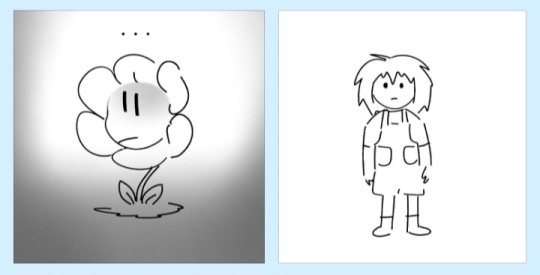
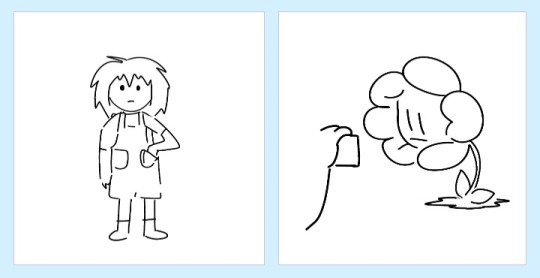
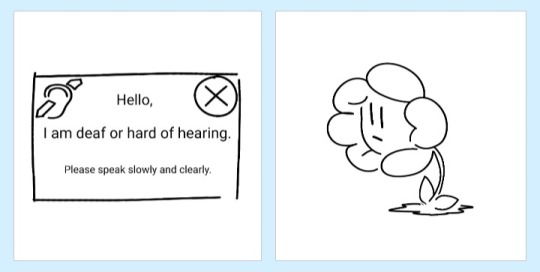
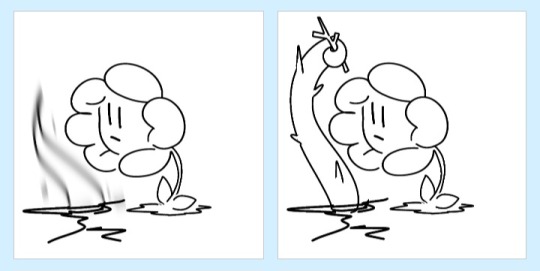
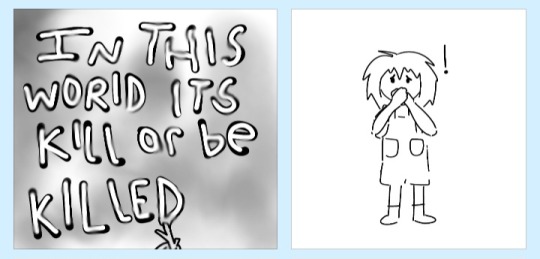
i think about this a lot. what if a deaf human fell down the mountain. would he make his threatening language accessible
#at least once a month i ponder#is he the type of guy to search for a language translator#or google “braille alphabet”#or look up “ASL easy tutorial fast”#to make sure his wrath is sent into the brains of everyone he stands before#undertale#flowey#charrator
43K notes
·
View notes
Text
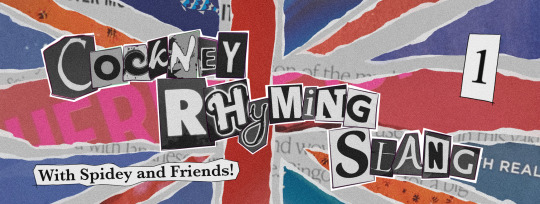
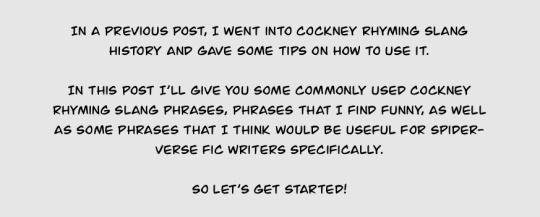

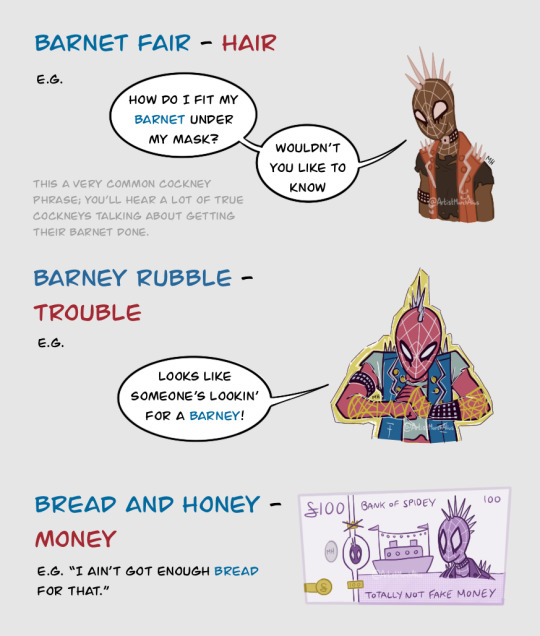
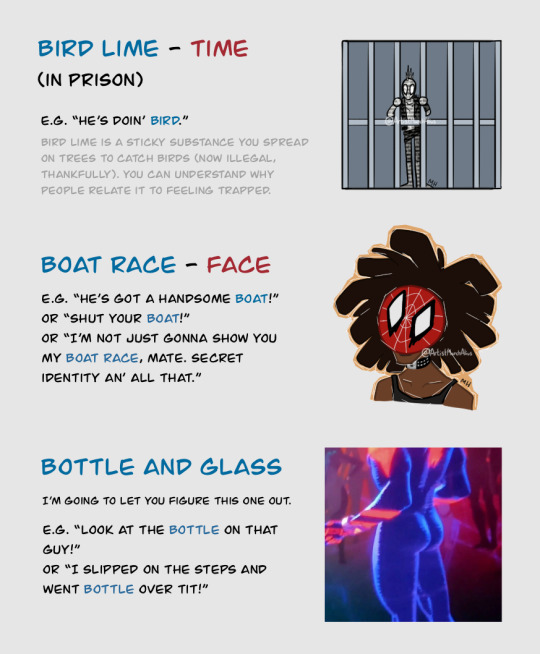

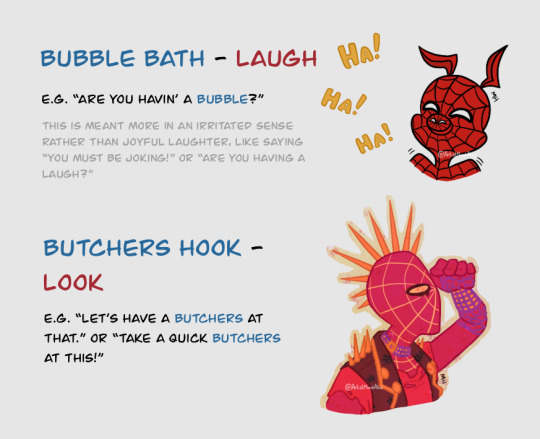
Cockney Rhyming Slang Phrases Part 1
Part 2
In a previous post I went into Cockney rhyming slang history and gave some tips on how to use it.
In this post I’ll give you some commonly used Cockney rhyming slang phrases, phrases that I find funny, as well as some phrases that I think would be useful for Spider-Verse fic writers specifically.
So let’s get started!
A-B
Adam and Eve - Believe
E.g. “I don’t Adam and Eve it!”
Apples and Pears - Stairs
E.g. “He fell down the apples.”
Aunt Joanna - Piano
E.g. “Play me a song on the old Joanna!” Or “Get on the Joanna and we’ll have a sing song!”
Barnet Fair - Hair
E.g. “How do I fit my barnet under my mask? Wouldn’t you like to know.”
This is a very common Cockney phrase; you’ll hear a lot of true Cockneys talking about getting their barnet done.
Barney Rubble - Trouble
E.g. “Looks like someone’s lookin’ for a Barney!”
Bread and Honey - Money
E.g. “I ain’t got enough bread for that.”
Bird Lime - Time (in prison)
E.g. “He’s doin’ bird.”
Bird lime is a sticky substance you spread on trees to catch birds (now illegal, thankfully). You can understand why people relate it to feeling trapped.
Boat Race - Face
E.g. “He’s got a handsome boat!” Or “Shut your boat!” Or “I’m not just gonna show you my boat race, mate. Secret identity and all that.”
Bottle and Glass
I’m going to let you figure this one out.
E.g. “Look at the bottle on that guy!” Or “I slipped on the steps and went bottle over tit!”
Brass Tacks - Facts
E.g. “Let’s get down to brass tacks!”*
*Some people think that this phrase originates from the Cockney rhyming slang, however others say that it is referring to brass tacks used in upholstery or tacks that were hammered into sales counters to indicate measuring points. I don’t have the answer.
Brown Bread - Dead
E.g. “He’s brown bread!”
This is an example of a Cockney rhyming slang phrase that you don’t abbreviate. You always say “brown bread” and never just “brown”.
Bubble Bath - Laugh
E.g. “Are you having a bubble?”
This is meant more in an irritated sense rather than joyful laughter, like saying “You must be joking!” Or “Are you having a laugh?”
Butchers Hook - Look
E.g. “Let’s have a butchers at that.” Or “Take a quick butchers at this!”
It’s good to keep in mind that there can be multiple Cockney rhyming slang phrases for the same word, as well as multiple Cockney rhyming slang phrases that start with the same word. For example, ‘Birds Nest” and “Bristol and West” both mean chest, and “Birds Nest” and “Bird Lime” both can be abbreviated to “Bird”. For the latter, context is important for knowing what someone is talking about.
As always, I’m not an expert; a true Cockney would know far more than I do. I just want to share the knowledge that I have. I hope that someone will find this helpful, informative, or entertaining at the very least.
I’ve got more Cockney rhyming slang phrases coming, but if there’s any other areas of British slang you’d like me to go into, let me know and I’ll see what I can do!
Happy writing and happy speaking!
My other British slang posts: Cockney Rhyming Slang, British Police Slang, Terms of Endearment, Innit VS In’t - a PSA
#hobie brown#spider punk#atsv#hobie brown fanfiction#writing help#cockney rhyming slang#british slang#fic help#across the spiderverse#hobie brown fanart#writing#writing tips#comic#language#I messed up the alphabetical order#my bad#just one of those things that reminds me I’m dyslexic
2K notes
·
View notes
Text
japanese learners/japanese speakers, is there any solid dictionary that i can use to look up words? like larousse for french, is there any websites/dictionaries for japanese?
#japanese#japanese language#japanese learning#im thinking of getting into it for real#so i thought i could start by learning vocab but i need solid stuff#i can look it up online sure but are they true? are they really giving / showing me what i wanna know?#i don't wanna triple check for each word i want to look up or learn#so help is muuuuch appreaciate it#also i think learning vocab is the least scary way to learn japanese alphabets so this is actually the main reason why im asking +#+ for a solid dictionary#thank youuu#blablabla
223 notes
·
View notes
Text
PARSELSCRIPT!!
Hi. This is mostly for the people from Discord but tadah! I'm finally making that Tumblr post I've been talking about for months.
(Warning this will probably be very chaotic)
To anyone new who sees this: me and some friends made an alphabet for Parseltongue from Harry Potter, aka Parselscript. I'll take you on a little journey to explain my process and give you some tips, should you want to start writing it.
Disclaimer: I wanted to make this script usable for the writer I made it for so it's less of an actual language and more just some characters to represent the Latin (or ‘English’) letters. Like a cipher. It is not realistic. If I made this realistic I'd have to add all sorts of things to indicate body language and smell etc and also have to figure out what sounds Parseltongue actually has etcetera etcetera. No.
Alright.
It all started when we started talking about Parselscript in a Discord server and I asked my friend Ava to visualise the script because she seemed to have a clear vision of it, so I could use it to go from there.
That's how we got this.

I think we all wanted to go with something flowery for some reason, so we did.
After this I just messed around with brushes and shapes in Procreate for a while, tweaking things and trying to make it more writeable. I ended up with something like this (still a rough draft).
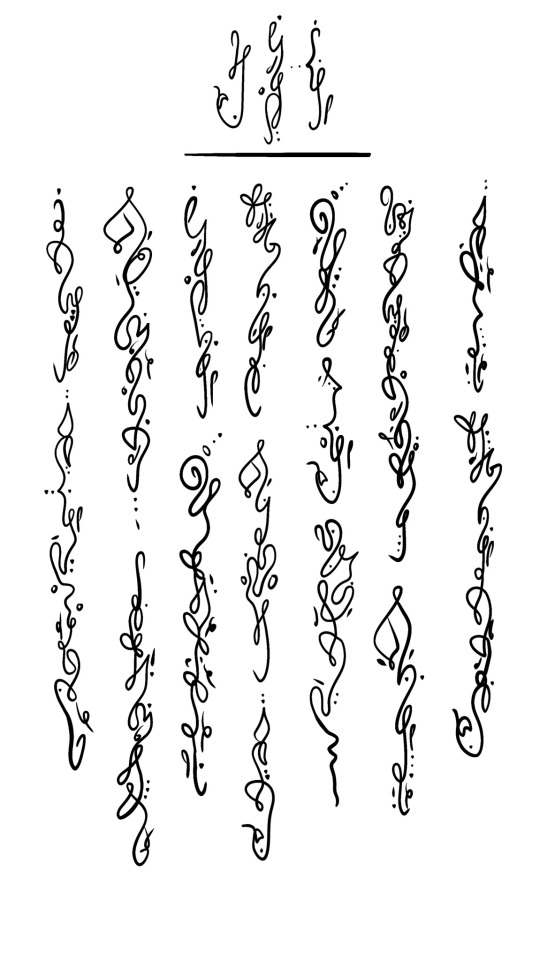
It may look a bit like random squiggles at first, and it kinda was at this point. As you can see there's also a lot of added dots and lines, which can be a bit hard to remember and I see you wondering what it looks like without them.
Well here it is.
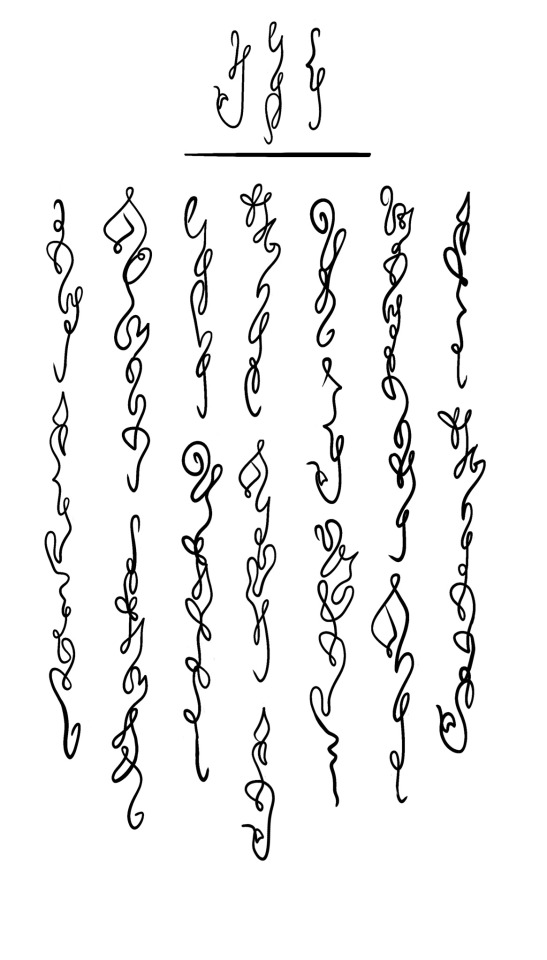
I showed this to the people I brainstormed with in Discord and we decided to go with the more complicated version because it looks better lol.
This is one of the final versions.
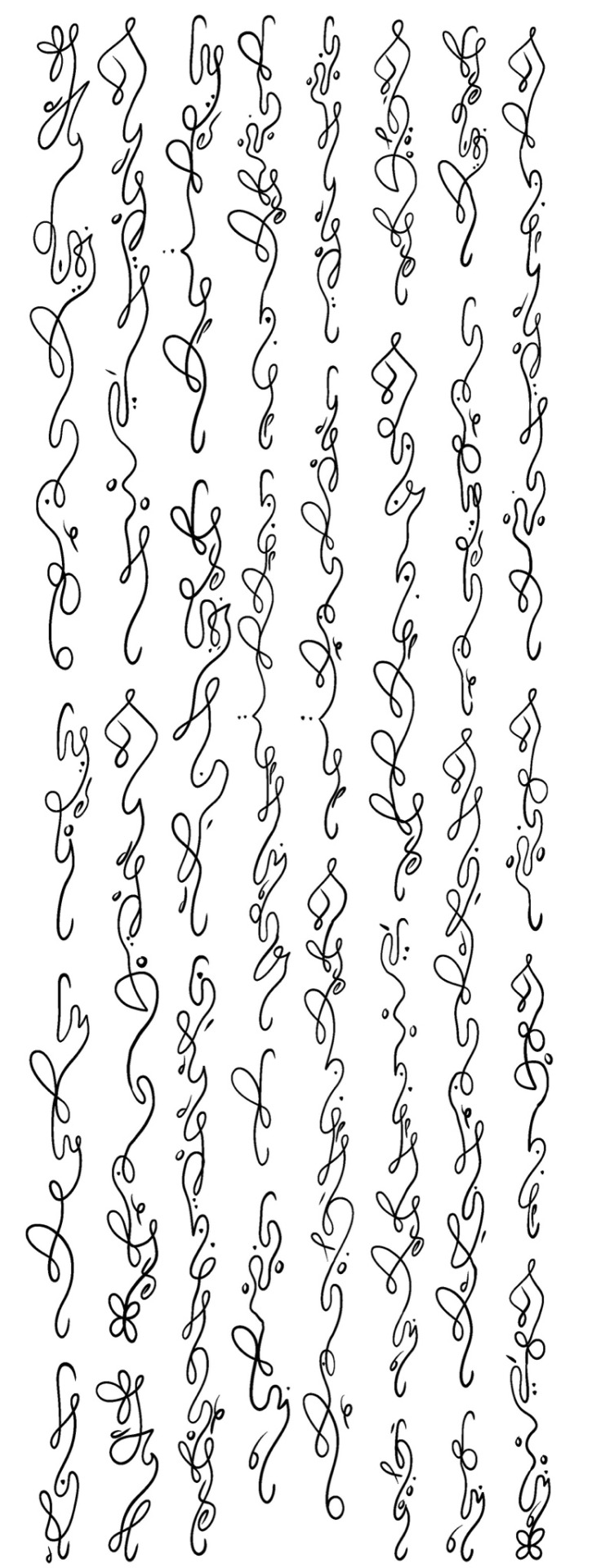
It says: "Hello, my name is Kiwi Cult. I made this script after reading a fanfic called Terrible, But Great written by Isalise the loml on Archive Of Our Own."
Now, to talk about some of the (boring) logistics.
It is read from left to right, top to bottom.
Every separate combination of squiggles you see above is a separate word. Every word is made up of a starting character, one or more letter characters and an ending character.
The very first character you see in the top left corner, with the three petal looking thingies, is a silent starting character that indicates the start of a sentence. Not word: sentence. The end of the character, that little circle thingy, is a comma. So, the first combination says: "Hello,".
Then, the second combination starts with a kind of hook going down and right. This is also a silent character and more meant as an interpunction, that's why you don't pronounce it. It's kind of just a way to start the word when there isn't anything special about it (aka it's not the start of a sentence, a name, an exclamation or a question. But every character is special in its own right🥲). The same kind of hook can be found at the bottom of the combination, except going up. It has the same use, basically just a way to end the word when there isn't anything special about it. Now, you might ask: why does it go right and not left?
We talked about this a while, because I wanted the direction to have some kind of meaning. We wondered about gender, tone, blah blah all kinds of complicated things but in the end I just wanted this script to be writable so I chose to have proficient writers in Parseltongue make their hooks go left and beginners have their hooks go right.
Now, you might notice that I end my words with a hook going right. That is because I don't see myself as a pro in writing in Parselscript okay? It's hard!😭💀
Now, other than the character indicating the start of a sentence, the circle, and the simple hook, there are a few other characters to start or end a combination (don't worry I'll show them all to you at the end, you won't have to use your imagination for long).
We have a character to indicate a name. Now, the rule is: name indicator over start of sentence indicator. So, if you start a sentence with a name, you'll use the symbol to indicate a name, NOT BOTH. (That's not even possible but I don't even want to see you try and butcher my child).
There is a character to indicate a sentence that would usually be followed by an exclamation mark (!), but at the start of the sentence. Then you’d end the exclamated sentence with a period.
The same goes for a question mark (?): put it at the start of a question, not the end. Again, it wouldn't even be possible to use it at the end of a combination but I DON'T EVEN WANNA SEE YOU TRY.
Finally we have a period (.), which looks a bit like a flower with four petals. You do use this one at the end of a word, and it is always followed by a start of sentence indicator or a name indicator. I know people are rejecting capitals these days in their typing but I don't wanna see it. If you start a word after a period with a hook I will find you.
So, to put it all next to each other, the symbols we have are:
-start of sentence indicator
-name indicator
-exclamation mark (!)
-question mark (?)
-period (.)
-hook (direction depends on efficiency)
-comma (,) (direction depends on efficiency)
I didn't make adjusted characters to indicate a capital letter like we do in the Latin alphabet, meaning that the only things you can kind of 'capitalise' are the start of a sentence and the start of a name.
It is also slightly phonetic. Emphasis on slightly. I made separate characters for almost all letters in the Latin alphabet, so you can just write your word normally with Parselscript characters. The only difference is that I made only one character for the 'f/v' sounds and that there is no 'c' character. If a word has a 'c' in it, you'll have to use the character for a 'k' or an 's'. Also a ‘q’ can be made with ‘k’ and ‘w’ etc.
A few examples:
-character=karakter
-parselscript=parselskript
-crazy=krazy
-science=siense
-quiz=kwuiz
I know it looks a bit confusing, but I trust you guys' ability to read context clues and figure out what someone means when you try to decipher Parselscript.
Now, for a word like 'phonetic' or 'decipher' I don't really care whether you use the separate characters for 'p' and 'h' or just the one for the 'f/v' sound. You do you.
I also don’t use any double letters because they basically sound the same and it looks ugly but if you want to use double symbols feel free.
I also made some numbers that do not look like they fit with the rest of the script but I promise you that's just because you're not used to it yet. Our own numbers don't belong with our alphabet either because we nicked them from the Arabs (I think, don't quote me on this) but we don’t notice that either.
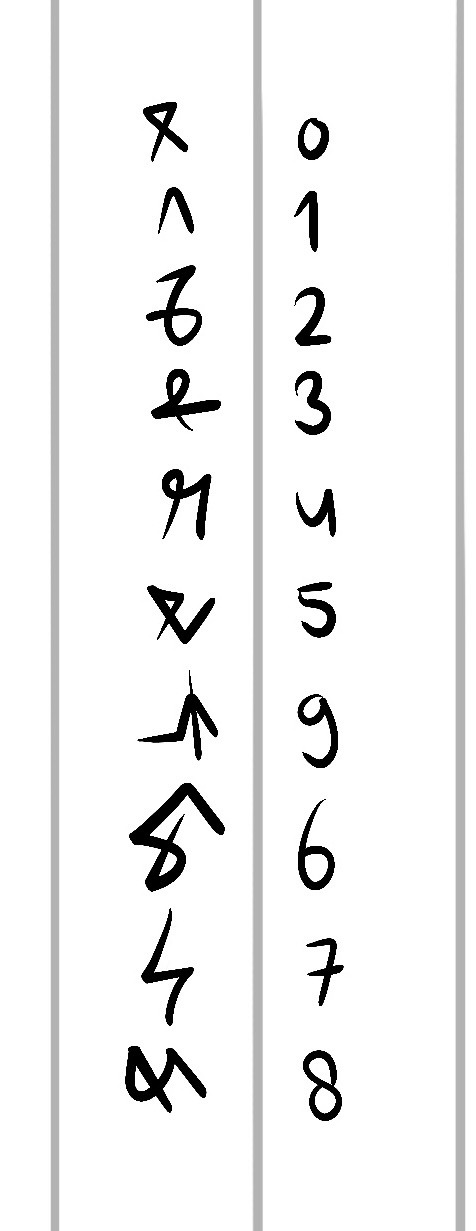
Tadah. (Yes I know it’s out of order I told you this was gonna be chaotic af)
Other than that, feel free to ask me questions if I've forgotten anything or if you're wondering about anything. I can't guarantee that I have a good answer because I might not even have thought about it myself, but I can always try to come up with something. I am one person, I'm afraid I haven't been able to take everything about a script into consideration.
Now, without further ado; here is the key.
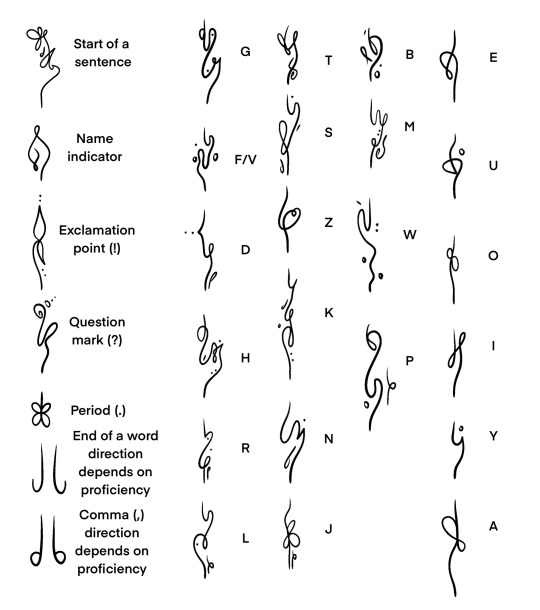

No, your eyes didn't deceive you: there are two versions. The first has a bit more loose squiggles than the second one. I realised that when I was writing physically, the second version was much nicer to write, so it is kind of like Simplified Parselscript. I haven't decided yet if I'm gonna put some lore behind it or not yet. But I included the og one if you're a tryhard and wanna take it on.
Now, if you're gonna start writing it yourself, here is the stroke order.
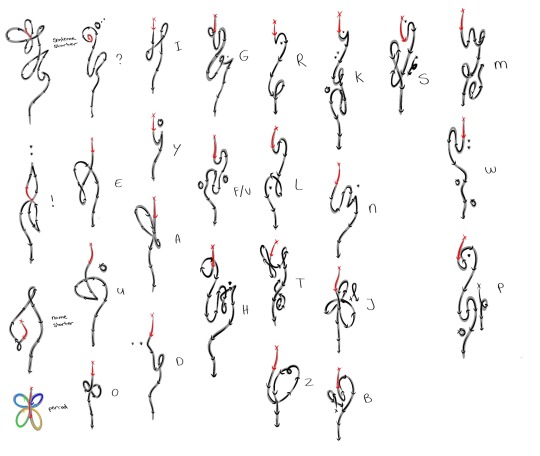
I tried to make it as clear as possible but please ask me if you're confused on anything.
Red is the starting point of the whole symbol, the arrows indicate the direction to go in, x marks the start of the small extra's.
Now, I'd also recommend writing on some type of paper with vertical lines like this if you're gonna do it physically.
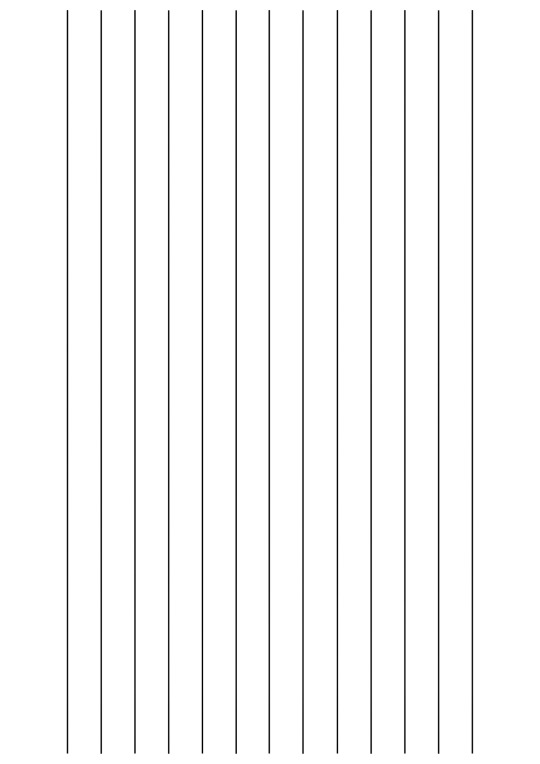
You can just turn a paper with normal, horizontal lines a quarter to get vertical lines. Also, do NOT write in between the lines. They are meant to help you keep the start and ending on the same line so you don't start going into crazy directions while writing. So, start your sentence symbol or hook or whatever in the middle of the line and try to keep coming back to that vertical line after every letter. As you gain more proficiency you'll probably go straight into the next letter without going back to the line all the time but I think this is a good starting point.
I also recommend writing with a fountain pen or something else that flows well because it’s easier to write that way.
Here is another rough draft I made on physical paper to get a feel for it. As you can see this draft had a lot more different starting characters and ending characters so just ignore that. Hope this motivates you a bit or smth.
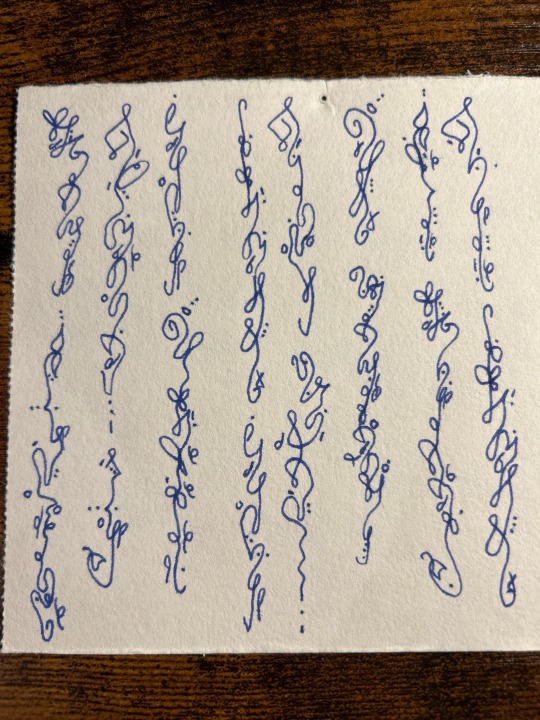
Lmk if you want me to post a video of me writing in this Parselscript.
Also please let me know if you know of someone else who's also made a Parselscript because I tried to look for it on Tumblr and Twitter etc but I couldn't find anything.
I also feel like there’s a big mistake I made that I realised the last time I worked on this script but I’ve forgotten it now so if you find out please comment or dm or anything💀
Also feel free to use in your own fic, tho a little tiny shoutout in the a/n would be nice :) I’m @/kiwi_cult on Ao3, @/slvtr_ on Wattpad, @/kiwi cult on ff.net, @/slvtr.1 on TikTok and @/.slvtr on Discord.
Credits:
@natis-balamnimaja @asterialvia and @/zee (who unfortunately left the server and I don't know the Tumblr @ of) for brainstorming with me and @isalisewrites for inspiring us and making the server we discussed this in.
Okay bye :) tell me if I forgot anything.
🥝
#fanfiction#isalise#parselscript#parseltongue#hogwarts#harry potter#language stuff#alphabet#script#tom riddle#worldbuilding#ao3
160 notes
·
View notes
Text
I made an alphabet :0

It's based on circles. The Gray ones (like the A E O etc.) are addons to the black circles. For example, L is a circle with two straight lines, but LO is a circle with two straight lines and a small triangle on the top.

You build a word by drawing circles, one inside another to create patterns such as in the one in the picture above. the picture also shows how the addons work in practice.

To write a sentence you have to put the words in a vertical line. It should be read from up to down and every sentence is ended with a period. I tried to make this look like a solar system map so it can look more futuristic/alienish. I hope you like the idea. I'll try to make a whole language out of it so wish my luck :3
#and no it doesn't have a name yet#alphabet#worldbuilding#language#alien#alien language#made up language
365 notes
·
View notes
Text

Posted by Nickelodeon on Facebook
#tmnt#ASL#ASL alphabet#LSQ#Alphabet LSQ#American sign language#langue des signes québécoise#fun fact ASL and LSQ have similarities and they share the same alphabet
574 notes
·
View notes
Text

548 notes
·
View notes
Text
I've spent an inordinate amount of time parsing the few examples we have of Old High Gallifreyan text, and here at last is the result of my labors!
The Old Gallifreyan alphabet:
The alternate forms of letters may be used interchangeably with their main forms; the differences are purely cosmetic, much like the difference between cursive and print-style writing.
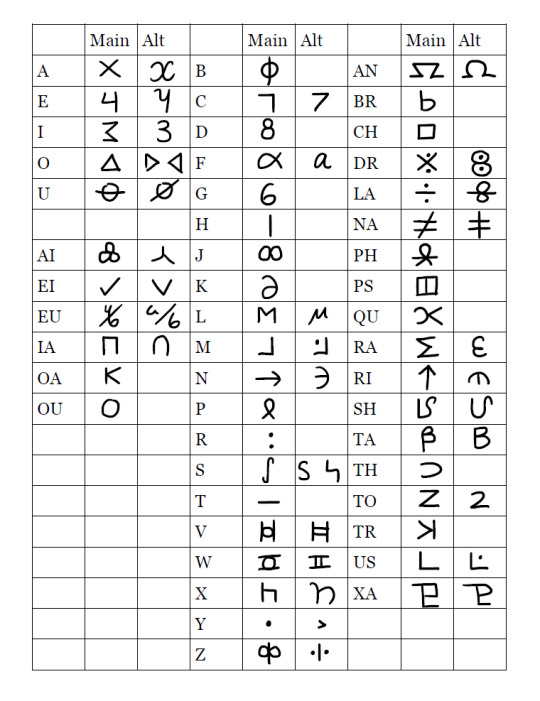
Now for my analysis of the existing texts. It's rather long, so I've put it below the break!
EXAMPLES OF OLD HIGH GALLIFREYAN TEXT
ITEM ONE

Supposedly from “The Five Doctors,” though I can’t spot this writing anywhere. Translation given in episode.

ORA PSYERPA
O – honorific indicating uniqueness, may be rendered with the definite article “the”
R – combined with the definite honorific, a common abbreviation of Rassilon’s name
A – an alternate version of the possessive “ya,” used only when the possessive noun is already abbreviated
Psyerpa – a general term for harps and other large stringed instruments
Thus, the full text reads:
O-Rassilon-ya psyerpa
The Rassilon’s harp
ITEM TWO

From “The Colony in Space,” across the bottom of the Doctor’s mugshot. No translation given.

QU ETHOA TRIOUAX BRIA
Qu – This is not a complete word, merely a letter used in this case for alphanumerical file designation: note that it stands alone, separate from the main text.
Ethoa – exile
Triouax – an infinitive verb, “to persist” or “to remain in effect”
Bria – a conditional modifier used exclusively in bureaucratic contexts, implying the need for occasional update of information or policy.
This text is a record of the Doctor’s sentence, and may be rendered something like this: Exile: to remain in effect barring further review.
ITEM THREE
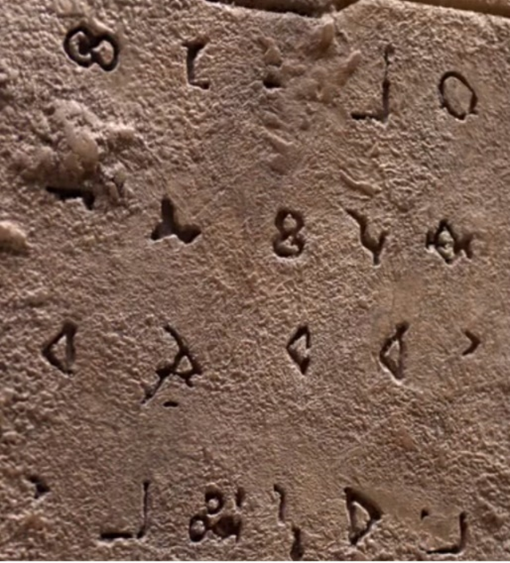
From “The Time of Angels.” Translation given.

JUSYMOU CAIDEU OXA OOYY MAISOM
Jusymou – An archaic greeting, roughly equivalent to “well met” or “hail.”
Caideu – self, soul, or “hearts” in a poetic sense
Oxa – prepositional suffix, “part of”
OOYY – a conceptual abbreviation that combines the two meanings of the solitary letter O (definite article + symbol of individuality) and the mathematical use of the letter Y (usually indicating a dimensional shift). Literally, this means something like the individual, shifted two dimensions. In practice, it refers to a Time Lord’s fifth dimensional aspect.
Maisom – name, designation, identification
Thus, a literal translation would read something like this: Greetings, soul-linked fifth-dimensional name!
Or as the Doctor paraphrases it: Hello, Sweetie.
ITEM FOUR
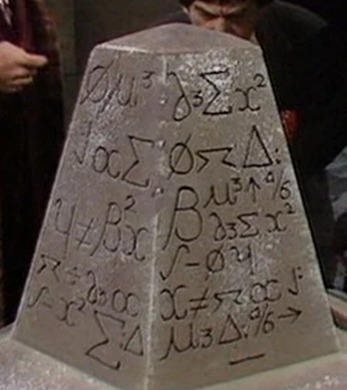
From “The Five Doctors.” Translation is given, though it’s not specified which face of the obelisk corresponds to which section of the text.
First Face:

RA NASA TO TANA EURIFSTAN OBLR ORE NATA
Ra – where
Nasa – sleep
To – in
Tana – lies, reclines, rests
Eurifstan – eternal, endless, timeless. Here it modifies the verb, so it should be rendered as an adverb.
Oblr – abbreviated form of obelar, tomb or grave
OR – the same abbreviation seen previously, “The One And Only Rassilon.”
E – an alternate version of the possessive “ya,” used only when the possessive noun is already abbreviated
Nata – a basic verb of being, is
This yields the following literal translation: Where sleep-in lies eternally, tomb Rassilon’s is.
Or as the Doctor translates it: This is the Tomb of Rassilon, where Rassilon lies in eternal sleep.
Second Face:
The text on the second face is never seen. The Doctor translates it as: Anyone who's got this far has passed many dangers and shown great courage and determination.
Third Face:

ULIREIF RAENATA TOAAN LAKI FSTA TORARO
Ulireif – to lose everything, to be utterly defeated
Raenata – an emphatic form of the being-verb nata, indicating that something really, truly, permanently is
Toa’an – to win everything, to be crowned victor
Laki – a compound conjunction combining la (so) with ki (and): “and so”
Fsta – an abbreviated form of festoa, a winner or leader
Toraro – future tense of torar, to fail or collapse
Thus: To lose all is truly to win all, and so the winner will fail.
Or as the Doctor puts it: To lose is to win, and he who wins shall lose.
Fourth Face:

KIRA ATOUNA OR TA LIRI EUKI RAATO SUTE ANAAN FEIRLIO REUNT
Kira – takes
Atouna – ring
OR – the same abbreviation seen previously, “The One And Only Rassilon.”
Ta – from
Liri – hand
Euki – a compound conjunction combining eu (then, next, afterward) with ki (and): “and then”
Ra’ato – future tense of ra’at, to wear
Sute – reward, prize, payment
Ana’an – desired, sought-after
Feirlio – future tense of feiril, to get or acquire. Note that this is an irregular verb: the last two letters switch places when adding any tense ending.
Reunt – immortality, eternity
Literally: Takes ring Rassilon-from-hand and then will wear, reward-sought will have: immortality.
Or as the Doctor translates it: Whoever takes the ring from Rassilon's hand and puts it on shall get the reward he seeks: immortality.
#doctor who#gallifreyan language#conlang#old high gallifreyan#no I have no idea how many hours I spent figuring this out#yes I'm working on figuring out the modern alphabet too (the one Four uses when he writes his letter at the beginning of Deadly Assassin)
231 notes
·
View notes
Text

A-L. Elementary exercises for the deaf. 1821.
Internet Archive
#alphabet#hand#hands#letters#asl#american sign language#deaf culutre#speech#chart#communications#nemfrog#1821#19th century
289 notes
·
View notes
Text

505 notes
·
View notes
Text
An interview in Gannan, Gansu province
English added by me :)
#douyin#video#tiktok#street interview#少数民族#for the alphabet part i guess#photoshoot#i can't tell what he says when he goes 's.k'#es que? est-ce que?#<-- my guess was one of those bc his chinese has sort of like a french/romantic language accent#idk#any guesses?#zao在甘南#藏语
643 notes
·
View notes
Text
youtube
Watch the 2024 American Climate Leadership Awards for High School Students now: https://youtu.be/5C-bb9PoRLc
The recording is now available on ecoAmerica's YouTube channel for viewers to be inspired by student climate leaders! Join Aishah-Nyeta Brown & Jerome Foster II and be inspired by student climate leaders as we recognize the High School Student finalists. Watch now to find out which student received the $25,000 grand prize and top recognition!
#ACLA24#ACLA24HighSchoolStudents#youtube#youtube video#climate leaders#climate solutions#climate action#climate and environment#climate#climate change#climate and health#climate blog#climate justice#climate news#weather and climate#environmental news#environment#environmental awareness#environment and health#environmental#environmental issues#environmental education#environmental justice#environmental protection#environmental health#high school students#high school#youth#youth of america#school
16K notes
·
View notes
Text
Fun fact about chants of sennaar,
If you replay the game on language settings that you don't speak you unlock translation puzzles 2.0
#I've memorized basically every language#except for the bards and the exiles#bards because I just can't wrap my head around the syntax and the alphabet doesn't like to stick#and exiles because there's no interesting puzzles or core gameplay to learning their language#but reading messages in the fictional language with a real world language on top?#idk#makes the game much more fun to me#chants of sennaar
179 notes
·
View notes
Text

Evolution of the Modern Latin Script (Extended Chart)
#language#alphabet#etymology#language learning#learning#educational#world culture#europe#european#teachers#charts#chart#guide#guides#infographic#infographics
162 notes
·
View notes
Text
A phonetic alphabet for sperm whales proposed by Daniela Rus, Antonio Torralba and Jacob Andreas.
The open-access study published in Nature Communications titled 'Contextual and combinatorial structure in sperm whale vocalisations', has analysed sperm whale vocalizations and as part of that, a phonetic 'alphabet' has been proposed for them.
So cool. Dolphins next please.

MIT news also did an article on this
#whale#sperm whale#cetacean#language#animal language#animal vocalisation#click language#clicks#inspiration#conlang#language creation#spec bio#speculative biology#speculative evolution#speculative worldbuilding#speculative fiction#inspo#machine learning#ai#communication#phonetic#alphabet#so cool#cool shit#nature communications
50 notes
·
View notes
Note
Random question:
So a while back I read something where someone was talking about how if English spelling were reformed so every sound had a unique symbol that we’d lose the “visual alliteration” of Cape Cod.
I cannot figure out what that means. Are those /k/ sounds not both [k]? The only difference I’ve been able to notice is a feeling of the airstream moving outward in “Cape” and inward in “Cod”, but I can’t tell if that’s due to vowel influence or what.
Let's back up. The "someone" who was talking about this was either (a) wrong, (b) uncooperatively pedantic, or (c) imagining a very specific, non-alphabetic spelling reform of English (e.g. spelling English with logographic or syllabic glyphs).
Assuming (b), the only way that English spelling could be reformed such that the C's in Cape Cod would be different is if the spelling reforming was as sensitive as a narrow IPA transcription. If that was the case, then there are some transcriptions of English that would transcribe the first as [kʰʲ] and the second as [kʰ]. This level is detail is phonologically important for some languages. English is not one of these. A sensible spelling reform would spell those the same, whether C (because all instances of [k] become C) or K (because all instances of [k] become K). A nonsensical spelling reform would actually spell aspirated and unaspirated voiceless stops different, but even then, these two would be the same, as they're both aspirated.
The airstream is the same for both (egressive). What you're feeling, I expect, is the very slight movement in tongue position as the initial [k], which is palatalized, moves backward to an unpalatalized position. The reason you feel this is the tongue doesn't have to do anything in between the onset of the first word and the onset of the second. The tongue gets in position for [e], and in this position you can pronounce [k] well enough, then with [p], your tongue doesn't have to do anything; the lips take care of it. This means your tongue body can remain in place. For "Cod", it moves back as the tongue prepares to pronounce [ɑ] (or whatever back vowel you have there). Notice also that the tongue body has to go down, the tongue tip retracting slightly to pronounce [ɑ]. That's all part of it.
Now, assuming (c), yeah, that's indeed going to happen. Consider Japanese katakana. This is how "Cape Cod" is spelled: ケープコッド /keːpu koddo/. The relevant characters—the ones that begin each syllable—are ケ /ke/ and コ /ko/. And, yeah, they're different, so you do lose the visual alliteration. However, what you lose in visual similarity you gain in economy. To write /ka, ke, ki, ko, ku/ in an alphabet you need 6 different letter forms and 10 total glyphs. To write the same thing in katakana you need 5 different letter forms and 5 total glyphs. Consider an old style text message, which had a hard character count. A syllabary allows you to fit more letters in than an alphabet because each character encodes more information. When it comes to sheer character count, then, the Japanese writing system is much more efficient when it comes to writing Japanese than the English Romanization is.
Of course, that's for Japanese. For English it doesn't make as much sense because of our overabundance of consonant clusters. Typing lava in an alphabet takes 4 characters; in a syllabary, it takes 2. Typing straps, though, requires 6 characters in an alphabet and 5 in a syllabary. That doesn't save you a lot space—and a syllabary like Japanese's throws in extra vowels that have to be there, even if they're not pronounced, destroying its efficiency by, essentially, adding extra noise to the signal. Returning to straps, you have 6 characters, and all elements are vocalized. In katakana, you'd have to do ストラプス /sutorapusu/. You save a character with ラ /ra/, but then you have a whole bunch of vowels you have to remember not to pronounce.
Long story short, if you were going to reform the English spelling system, I don't think a syllabary (or even an abugida) makes sense, and a logography would be quite a thing to drop on the unsuspecting populace, even if it would be more equitable. This is why I guessed that what you overheard wasn't (c) and was likely (b).
Anyway, that's my 2¢. Hope it helps.
#language#linguistics#orthography#spelling#English#Japanese#syllabary#logography#alphabet#spelling reform
70 notes
·
View notes
Text
youtube
Watch the American Climate Leadership Awards 2024 now: https://youtu.be/bWiW4Rp8vF0?feature=shared
The American Climate Leadership Awards 2024 broadcast recording is now available on ecoAmerica's YouTube channel for viewers to be inspired by active climate leaders. Watch to find out which finalist received the $50,000 grand prize! Hosted by Vanessa Hauc and featuring Bill McKibben and Katharine Hayhoe!
#ACLA24#ACLA24Leaders#youtube#youtube video#climate leaders#climate solutions#climate action#climate and environment#climate#climate change#climate and health#climate blog#climate justice#climate news#weather and climate#environmental news#environment#environmental awareness#environment and health#environmental#environmental issues#environmental justice#environment protection#environmental health#Youtube
16K notes
·
View notes